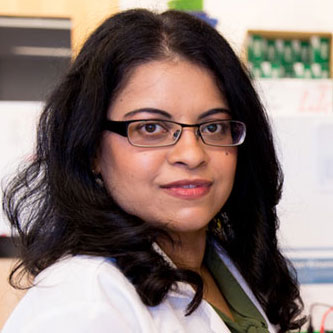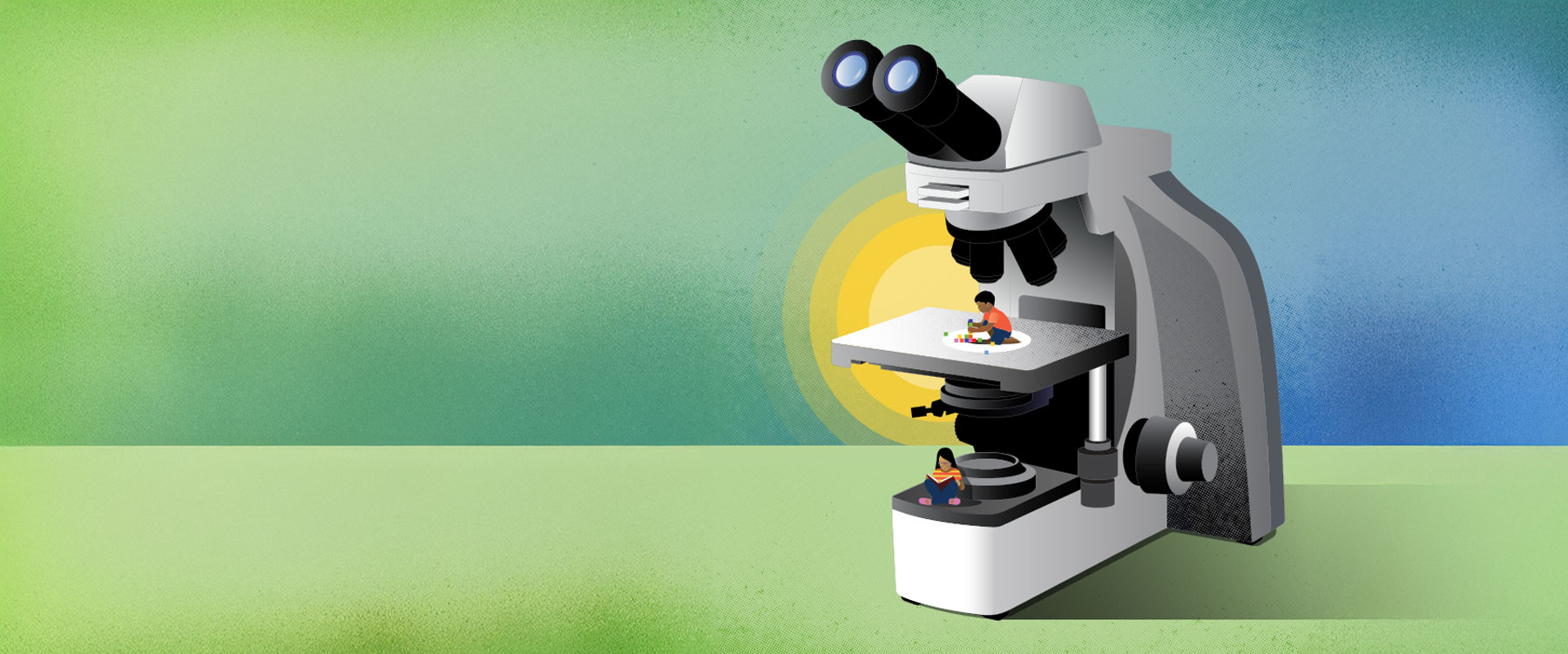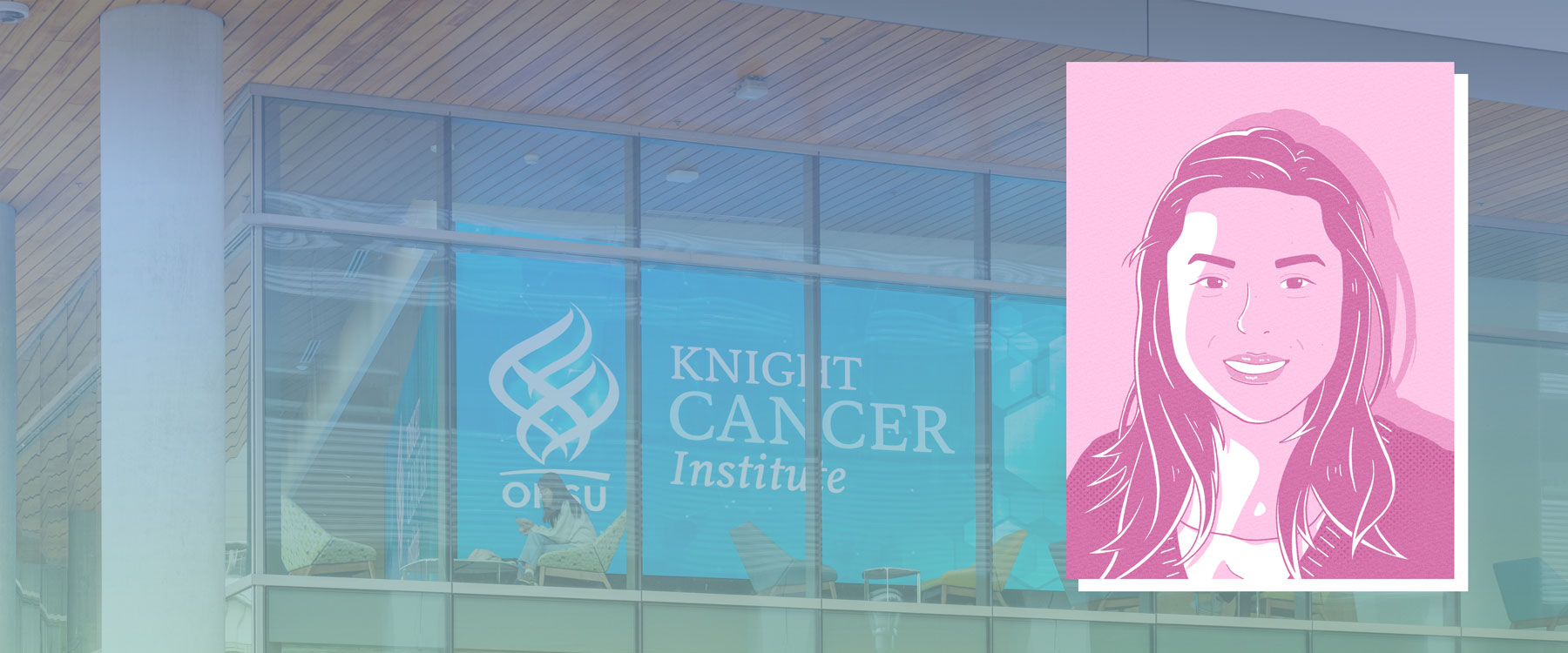By Darby Kendall
For Ignite Magazine
Illustration by David Sims
Products and goods made for children are often simply smaller versions of their adult counterparts — shoes, plates, guitars and toy cars, all shrunk down to a petite scale. When it comes to children’s health care, however, there’s nothing small about it.
In the medical world, research on adults cannot be simply sized down for the pediatric population. Kids aren’t miniature adults. Their bodies, systems and brains are still developing and growing. Research conducted on adults can’t just shrink to fit their developing bodies and minds.
And because kids have their entire lives ahead of them, it’s especially important to minimize long-term side effects of any new therapy or treatment.
We spoke with OHSU Doernbecher Children’s Hospital providers from a variety of specialties for insight into the vital and life-saving importance of pediatric research. Doernbecher’s decades-long leadership in the field has led to leaps and bounds in children’s health care, and these professionals are making sure the progress never stops.
Panelists

Deborah Lewinsohn, M.D.

Monika Davare, Ph.D.

Trevor Hall, Psy.D., ABPdN
Deborah Lewinsohn, M.D., is the vice chair of Research at OHSU, interim director of the Papé Family Pediatric Research Institute, and Wayne L. Tracy professor of Infectious Disease. Her pediatrics specialty is in infectious diseases, and she’s the assistant director of the Center for Global Child Health Research.
Monika Davare, Ph.D., is the assistant director of the Papé Family Pediatric Research Institute and the Sada and Rebecca distinguished scholar of Pediatric Hematology Oncology. She is a cancer scientist with a lab at Doernbecher focused on pediatric hematology and oncology.
Trevor Hall, Psy.D., ABPdN, is a pediatric neuropsychologist specializing in care for youth with central nervous system complications.
Q: What drew you to the field of pediatrics and children’s health?
Trevor Hall: I tried on a couple of different hats in college. I eventually declared psychology as my major area of study — mostly because I thought human behavior is interesting. When I started graduate school in clinical psychology, my mentor quickly realized that my high energy and youthful temperament might be well-suited to working with children. Obviously, I agreed, and for the past 24 years the focus of my professional life has been wholly focused on children, adolescents and their families.
In short, I love my job! With the risk of sounding cliché, to me, my work does not really feel like work. Don’t get me wrong, the work is often hard and filled with complexity, but the joy, meaningfulness and sense of purpose that comes from helping a pediatric population is something I view as a gift. I am motivated by seeing children not only survive, but by doing what I can (as part of a team) to help them thrive as they recover and re-enter back into their lives.
Deborah Lewinsohn: I went into children’s health care because as pediatricians, we can positively influence a child’s health trajectory over a long lifespan. I chose infectious disease because infections are the leading cause of illness and death of children worldwide and in many cases, we can prevent disease with effective vaccines.
Monika Davare: Children represent our future, yet for those diagnosed with chronic or life-threatening illnesses, that future is profoundly altered. Unlike adults, children are among the most vulnerable patients — they cannot advocate for themselves, making it essential for researchers and clinicians to champion their needs.
When my own daughter faced a health issue very early in life, I experienced firsthand how deeply a child’s illness affects not only the parents but the entire family and surrounding community. It was a stark reminder that pediatric health is not just about treating a single patient — it is about preserving the well-being and stability of families, support networks, and ultimately, society as a whole. Seeing a child in distress, knowing how much is at stake, and understanding that better treatments could change the course of their life is what fuels my dedication to this work.
“Children represent our future, yet for those diagnosed with chronic or life-threatening illnesses, that future is profoundly altered. Unlike adults, children are among the most vulnerable patients — they cannot advocate for themselves, making it essential for researchers and clinicians to champion their needs.”
— Monika Davare, Ph.D.
Q: How is research in pediatrics different from research on adult populations?
Lewinsohn: When pursuing pediatric research, we have to consider that as the child is developing, the biology that we are studying changes with age, making the design of studies and interpretation of results more complex. For example, from birth to around 5 years of age, the immune system undergoes significant maturation. As the immune system is very immature at birth, newborns are very susceptible to severe infection and are unable to respond as well to vaccinations as older children and adults. Understanding how the immune system works at different ages is important for new innovations in preventing, diagnosing and treating childhood infectious diseases.
Hall: I firmly believe that children are the most important people on the planet. As such, I think they deserve innovative and high-level research programs focused on child- specific concerns with an emphasis on long-term health and well-being.
Unfortunately, in comparison to research on adult health, pediatric initiatives are woefully underrepresented and those that do exist commonly receive less support.
Davare: Pediatric cancer research has historically been underfunded and lags behind adult oncology in terms of new treatment options.
Many current therapies are based on decades-old protocols, often leading to significant long-term side effects for survivors. Unlike adult cancers, which benefit from substantial investment by the pharmaceutical industry, pediatric cancers receive less attention from the private sector due to the relatively smaller market size. As a result, progress in developing targeted therapies has been slow, leaving young patients with limited options.
This reality drives my work. By focusing on pediatric cancers, I aim to help bridge this gap — bringing new, more precise treatments to children and adolescents, improving survival rates while also minimizing the lifelong health consequences of outdated, highly toxic therapies. Children deserve more than just the chance to survive; they deserve the opportunity to thrive.
Q: Why is working at an academic health center beneficial to your research?
Hall: Working in an academic health center is critical for the type of work I do. From a clinical standpoint, as part of a multidisciplinary team, I support children and families from the time they come to Doernbecher to even after they go home, for as long as needed. From a research standpoint, the same children and families help our multidisciplinary team to understand how to better support others in the future. Being housed in an academic health center allows for all the teamwork to happen.
Davare: Working at OHSU provides the agility and flexibility to pursue innovative and high-risk ideas in discovery science. It fosters a collaborative environment where I can engage with both clinical colleagues — who continually reinforce the urgency of the clinical need — and outstanding basic and translational scientists, with whom I can co-develop novel ideas, tools and breakthroughs. This ecosystem ensures that our research remains both cutting-edge and directly relevant to patient care.
Equally important, an academic health center offers the opportunity to train and mentor the next generation of scientists and physicians. Investing in young minds, guiding their research, and shaping their approach to scientific inquiry is one of the most rewarding aspects of my work. These interactions not only advance the field but also inspire a continued commitment to pediatric cancer research.
Lewinsohn: Only an academic health center can support the infrastructure, faculty and research trainees and staff, all of which are necessary for research innovation. In particular, graduate students, medical students, residents, post-docs and fellows are engines of research progress. Pediatric faculty, including academic clinicians, physician scientists and Ph.D. scientists, provide the catalyst
for child health research by collaborating to address the current gaps in knowledge within the field.
Q: How has philanthropy contributed to your professional efforts?
Davare: Pediatric cancer research would not be possible without philanthropic support. Despite the profound impact of childhood cancer, only about 4% of national cancer research funding is allocated to pediatric cancers — a stark gap in mission-critical work that philanthropy helps to fill.
In my own laboratory, philanthropic contributions have been transformative. Key pieces of equipment, funded through generous donations, have dramatically increased our research capacity, allowing us to test hundreds of drugs at a time rather than just a handful. These advancements have accelerated the pace of discovery and expanded our ability to identify promising therapeutic strategies. Additionally, discretionary philanthropic gifts have been instrumental in recruiting and retaining talented staff researchers, whose expertise is essential to driving progress. To say that philanthropy has been critical to my laboratory’s success would be an understatement.
Hall: I serve on a multidisciplinary team of clinicians in the Pediatric Critical Care and Neurotrauma Recovery Program (PCCNRP). Philanthropy has been a vital component to the PCCNRP’s success!




